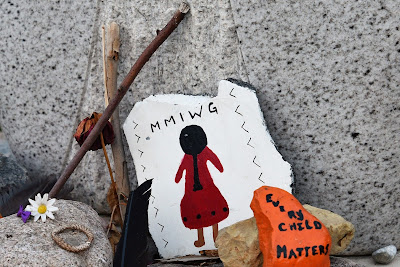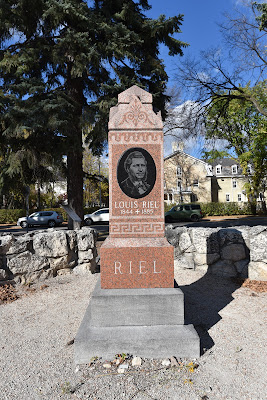Winnipeg Forks : Lived Realities and New Perspectives
After what felt like an endless confinement indoors, we burst forth into the fresh air and sunshine to explore Winnipeg once again, which is located on Treaty 1 Territory - the traditional territory of the Anishinabek and Métis People.
When we entered Manitoba's capital city last fall we explored some of its fascinating and somewhat troubled history. Looking back at our last blog entry from the trail in 2020, we were struck by how much of the history we learned along the trail coming into the city told the story of European settlers. Today, after a year in which many people have begun decolonizing their thinking and understanding, and only a few weeks after a mass grave with the bodies of 215 school children was discovered on the grounds of a residential school in BC, we saw this history from a very different perspective.
In Winnipeg, as in many parts of Canada, Indigenous issues are the lived realities of the city and not merely some matter to be debated in the hypothetical. While much of what we have come to experience and witness may feel uncomfortable to citizens of European descent - the fact is that public discomfort leads to new perspectives and change. In this instant in particular change as well as acknowledgement are long over due.


Our first stop this morning was revisiting Winnipeg's amazing Forks Market and the open outdoor park at the Forks National Historic Site along the banks of the Red and Assiniboine Rivers. This culturally significant park is known as 'the meeting place' and it celebrates human history dating back 6,000 years. Historical plaques, artifacts, and artistic exhibits are scattered throughout the park, celebrating Indigenous, Métis, and European cultural and historic events. We shared photos and descriptions of some these pieces in our blog from last fall, but during this visit we were struck by a very strong feeling that this meeting place sits at the centre of the confluence of geography, history, and culture. The rivers connect the east, west, and north. For 6,000 years, people have been meeting in this place to trade, negotiate, and settle. Indigenous peoples, Métis, and European settlers coexist here, and the struggle to find peace and reconciliation after the messy history we share is evident here. Perhaps it is on this place where we will find a way to honour the past while building a more balanced, equitable, just, and respectful future.
As we sat on the grass under the shady trees in the park reflecting on our times, we were delighted to see a small colony of Richardson's Ground Squirrels. These cute rodents are also known as dakrat or flicker tails, and are sometimes (incorrectly) referred to prairie dogs or gophers. They are native to the short grass prairies of central and western North America, but have adapted to urban areas, sometimes being considered a pest because of the burrows they dig in lawns.
Their social structure is centred around female kinship. Females fiercely defend their nest territories, but will tolerate other closely related females. Their burrows are grouped closely together, and they have two alarm calls for when predators approach - a high-pitched whistle for ground predators and a sharp 'chip' for aerial threats.
We watched as these cute ground squirrels popped their heads up out of their burrows, chased each other around, and yelled at us with bright red mouths wide open and filled with sandy dirt. As one squirrel would pop up and survey the grassy area on its hind legs, another would duck into its burrow, and a third would crouch, with just its eyes visible above the entrance to its tunnel. They were very entertaining to watch and we likely spent far too much time relaxing at Winnipeg's Forks enjoying these moments in nature.
After visiting The Forks we retraced our steps from last year, following the path along the river bank. We passed several small camps of homeless people, many of whom were Indigenous, and a few of whom greeted us as we passed. Not for the first time on this trail we were met by marginalized communities on the edges of a river, on the outskirts of a city. In many cases, as we have experienced in the past, it seems that many individuals simply want to talk and be acknowledged. As a result we enjoyed a number of amazing conversations with people camping out along the Trans Canada Trail who simply wanted their voices heard. Working towards equality and justice is certainly one of the most pressing challenges of our time.
As we followed the path along the river, in the wake of recent events, we noticed that many of the monuments dedicated to European settlers and colonial powers had been defaced. Flames had been spray painted on images of the Saint Boniface Cathedral. The word 'bad' had been spray painted beside statues and monuments commemorating the lives and work of the Grey Nuns, who were Catholic sisters and missionaries who worked in the nearby hospital.
In addition statues, historic plaques and signs throughout the city had been defaced reflecting the frustration with the ongoing inequalities. Just as many of the city trail signs often include stickers saying “built on stolen land” stuck to them, so too do many of the trees along city sidewalks have red and orange ribbons, the adopted sign of remembrance for lost indigenous women.
Here, as in so many other places across the nation the Indigenous peoples are struggling to have their voice heard, culture recognized, and history acknowledged. Standing at the centre of the country we could see and feel the struggle that is going on across Canada right now to acknowledge, accept, and heal from our troubled histories.
The trail took us to the Saint Boniface Cathedral, which is a Roman Catholic basilica and the principle church in the Roman Catholic Archdiocese of Saint Boniface. It is built on the site where the Rev. Norbert Provencher constructed the first church in 1818, on land donated by the Hudson's Bay Company's Thomas Douglas, the 5th Earl of Selkirk. The original log cabin served as a chapel, residence, and school, and was soon replaced by a larger structure. In 1832 the first cathedral was built, but it burned down in 1860. It was replaced, and by 1900, Saint Boniface again expanded, becoming the fifth largest church in the West. In 1968 a fire destroyed many of the features from the 1906 cathedral, with only the facade, sacristy, and walls of the old church remaining. A smaller cathedral was built inside the facade, which provides a striking silhouette.
As we approached the cathedral, both sides of the long paved walkway leading up to the entrance were lined with orange ribbons tied to wooden sticks, a lit candle at the base of each to commemorate the lives of the 215 Indigenous and Métis children who were found in a mass grave outside a Residential school in Kamloops, BC in early June. Standing in the soft evening light, with a nearly full moon rising in the pink sky and the strong, sweet smell of flowers hanging in the air, it was hard to grasp how such beauty and such horror are both possible in this world.
As we left the grounds we paused to visit the grave of Louis Riel, who is buried in the cemetery there, and the monument to Chief One Arrow. Louis Riel was one of the founders of the province of Manitoba, a Canadian politician, and a leader of the Métis people. He lead two uprisings against John A. Macdonald's federal government, seeking to defend Métis rights and identity, but eventually was hanged for treason. His conviction polarized our country, setting French Catholics against English Protestants in a division that has consequences to this day.
As we made our way back towards downtown we passed the imposing and imperial Legislative Buildings. On the vast green lawn in front we stopped to investigate a statue showing Nellie McClung, Louise McKinney, Irene Parlby, Emily Murphy, and Henrietta Muir Edwards. Led by Nellie McClung, these ladies worked hard to get Manitoba women the vote, getting legislation passed on January 27, 1916 that made them the first in Canada to be eligible to cast a vote.
A little farther across the grounds of the legislature we passed a monument commemorating the millions of victims of the Holodomer Famine Genocide in the Ukraine between 1932-1933. Many of the survivors of this forced starvation immigrated to Manitoba where they could live in peace and freedom. Seeing these two seemingly disconnected events commemorated side by side gave us the impression that the history and cultures of the prairie provinces are more varied and complex than we'd realized.
On our way back to our room for our final evening in downtown Winnipeg we noticed one last sign that the times are changing. On the corner one of the capital city's main roadways, the historic, imposing, and architecturally beautiful Hudson's Bay Co. store - a Canadian icon, once one of the most powerful corporations in the world, and a seemingly permanent fixture in Canadian malls - was bordered up and has itself become a relic of history. While the HBC was itself a product of an imperial age, and a corporation which at times had a problematic relationship with Indigenous persons in North America it was also a symbol of an age that has now come to an end - hopefully giving way to new possibilities.
On our walk through downtown today we could feel the shadows of history hanging heavy in the air, but we also watched as new graduates of the University of Winnipeg took photos in their caps and gowns at many of the historical monuments around the town. Their youth, vitality, and positive energy seemed to being hope for a better future.
See you on the trail!
Remember to follow our entire adventure here : www.comewalkwithus.online































Thank you for sharing all of this.
ReplyDelete